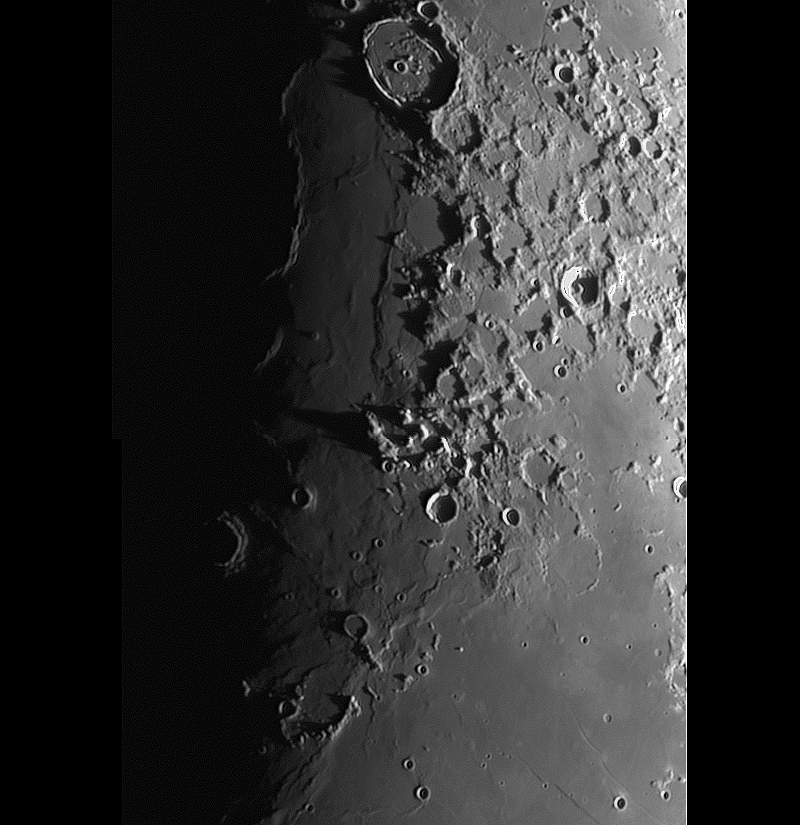El Mar de la Serenidad es un mar lunar, ubicado al este del Mare Imbrium y al sur del Mare Frigoris.
Se encuentra en la cuenca Serenitatis, que data del periodo Nectárico. El material que rodea al Mare es del periodo Ímbrico Inferior, mientras que el material de su interior es del Ímbrico Superior.1 La cubierta basáltica, que cubre casi todo su interior, e incluso rellena el Lacus Somniorum,1 refleja un largo periodo de actividad volcánica, aunque la conformación de la capa basáltica indica la existencia de material volcánico anterior al Mare.3
Su característica más destacable es el cráter Posidonius, en el borde noreste del mar. La pared este del mare es indistinguible, excepto por los Montes Haemus. Se conecta con el Mare Tranquillitatis en el sureste, y limita con el Mare Vaporum hacia el suroeste. Mare Serenitatis es un ejemplo de mascon (anomalía gravitatoria).
Las naves Luna 21 y Apolo 17 alunizaron en la zona este del Mare, en las proximidades de los Montes Taurus.
El mar de la Tranquilidad o Mare Tranquillitatis es un extenso mar lunar donde el 20 de julio de 1969 descendió el módulo lunar de la nave Apolo 11, con los astronautas Edwin Buzz Aldrin y Neil Armstrong, siendo este último la primera persona en pisar la superficie lunar, mientras que Michael Collins se quedó orbitando la Luna en el módulo de mando.
El primer astrónomo en asignar un nombre a este mar lunar fue Michael van Langren, flamenco al servicio de Felipe IV de España, en su Lumina Austriaca Philippica de 1645. Van Langren lo llamó "Mare Belgicum", uno de los nombres clásicos del Mar del Norte. Johannes Hevelius, en su mapa lunar de 1647, lo llamó "Pontus Euxinus", nombre clásico del Mar Negro.
El nombre de "Mare Tranquillitatis" fue otorgado en 1651 por los astrónomos jesuitas Francesco Grimaldi y Giovanni Battista Riccioli en su Almagestum novum,45 y es el que ha perdurado hasta hoy.
El material de mare dentro de la cuenca consiste en basalto formado en el grupo de edad intermedia a joven de la época del Alto Imbrian. Se cree que las montañas circundantes pertenecen a la época del Imbrio Inferior, pero la cuenca real es probablemente prenectariana. La cuenca tiene márgenes irregulares y carece de una estructura definida de múltiples anillos. La topografía irregular en y cerca de esta cuenca resulta de la intersección de las cuencas Tranquillitatis, Nectaris, Crisium, Fecunditatis y Serenitatis con dos anillos de la cuenca Procellarum. Palus Somni, en el borde nororiental del mar, está lleno del basalto que se derramó de Tranquillitatis.
Este mar tiene un ligero tinte azulado en relación con el resto de la Luna y se destaca bastante bien cuando se procesa y extrae el color de múltiples fotografías. Es probable que el color se deba a un mayor contenido de metal en el suelo o las rocas basálticas.
A diferencia de muchos otros maria, no hay concentración de masa (mascon), o alta gravitacional, en el centro de Mare Tranquillitatis. Se identificaron mascons en el centro de otros mares (como Serenitatis o Imbrium) a partir del seguimiento Doppler de las cinco naves espaciales Lunar Orbiter en 1968 El campo de gravedad se cartografió a mayor resolución con orbitadores posteriores como Lunar Prospector y GRAIL, que revelaron un patrón irregular.
Le Monnier es el remanente de un cráter de impacto lunar que ha sido parcialmente inundado por flujos de lava. Se encuentra en el borde oriental del Mare Serenitatis. La parte occidental de su borde ha desaparecido, formando una gran bahía. Al norte se halla el cráter Chacornac.
El interior de esta formación es relativamente plano y liso, sin accidentes significativos que marquen su superficie. El borde exterior aparece golpeado, desgastado y lleno de muescas como resultado de impactos pasados. Solamente unas pequeñas crestas indican el lugar donde estuvo situado el sector oeste del brocal.
El lugar de alunizaje de la sonda espacial Luna 21 se encuentra cerca del borde sur de Le Monnier. El Lunojod 2, un vehículo robotizado depositado en la superficie por el Luna 21, cubrió una distancia de 37 kilómetros a través del suelo del cráter, examinando también su borde sur.
Posidonius es un cráter de impacto lunar que está situado en el extremo nororiental del Mare Serenitatis, al sur del Lacus Somniorum. El cráter Chacornac está unido al borde sureste, y al norte se halla el cráter Daniell.
El borde de Posidonius es oscuro y poco profundo, especialmente en el borde occidental. Su interior ha sido cubierto por flujos de lava en el pasado. Los taludes del cráter todavía se pueden observar en el sur y en el este del borde del cráter, y en menor grado en el norte.
Presenta un borde semicircular interior, perteneciente a un cráter concéntrico, inundado dentro del borde principal, desplazado hacia el borde oriental. No posee ningún pico central, pero el suelo es montañoso y posee un sistema de grietas denominado Rimae Posidonius. La planta también está ligeramente abombada debido a una antigua efusión de lava, que también es probable que produjera el complejo de crestas. El extremo noreste es interrumpido por el cráter más pequeño Posidonius B. Dentro del borde del cráter, que se compensa justo al oeste del centro, aparece otro cráter más pequeño, Posidonius A.
En la superficie del Mar de la Serenidad, cerca de Posidonius, se localiza un sistema notable de dorsa que son paralelos a la costa cercana. Estos se designan como Dorsa Smirnov. La cima de estas crestas muestra un pequeño cráter con un diámetro de unos 2 km. Este cratercillo está rodeado por una zona de material de alto albedo, y es un ejemplo de un punto brillante lunar. Esta elevación fue designada anteriormente como Posidonius Gamma (γ).
Posidonius Gamma fue observado por primera vez por el cartógrafo lunar Julius Schmidt en 1857, quien señaló la similitud con la zona brillante que rodea el cráter Linné.

